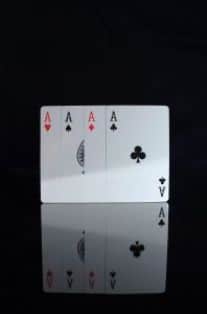Casino Poker Etiquette When Showing Your Hand and Who Shows Their Cards First?

By Steve Beauregard
“Show one, show all,” is the age-old poker saying, applied to those situations when you want to show another player your cards. But other situations are not as clear-cut.
It doesn’t have to be.
For some reason, many recreational poker players (I assume you fall into this category), take an overly-secretive, defensive crouch when it comes to showing everyone else at the table their holdings.
It shouldn’t be this way.
You’re playing low limit poker against amateurs, so just show your cards, win or lose. The guy in the third seat is a tourist from Dayton in town for a convention. He won’t remember that you three bet in middle position with Ace-Queen off-suit.
Don’t be afraid to show your cards, win or lose. If your hand is the best, you win the pot of course. And if you flip over your cards and they are second best? Well, you still would have lost if you had mucked them. Plus, showing your losing hand may lead other players to believe you aren’t very good. This means they will tend to call you when you bet, or bet when they have an inferior hand to yours.
Plus, there’s always that rare situation when you think you’ve lost, but have actually won.
I’ve done this myself. Once I called a players bet, and he showed a straight, which beat my three-of-a-kind. But since I don’t muck, I flipped over my cards, assuming I lost. It’s then when the dealer pointed out that I had actually made a flush. Had I wanted to be secretive, and project an air of mystery by tossing my 3 of a kind in the muck, I would have missed out on a pot.
Who Shows Their Cards on the River First?
So as you can tell, I’m in the school that when playing the low limits, everyone should show their cards face up at the end of a hand.
Having said that, some of you will feel embarrassed with your holdings and not want to show them to the rest of the table.
Fair enough, so let’s go over the rules and etiquette for who shows their hand first.
If, after the river card has been dealt the person who makes the last bet or raise is the one required to show his hand first.
If there is no bet on the river, the hand is over. If players pause or hesitate to show their hand, typically the dealer will get impatient and say something along the lines of “Somebody show me a winner.”
If still nobody wants to show (I’ve seen these “no show showdowns” before), the player who is closest to the left of the dealer button is required to show first.
Often times however, there will be a bet on the river. And if someone calls a final bet, the person who calls has the option of seeing the bettor’s hand first.
An exception occurs when the caller doesn’t wait for you and immediately flops over a winning hand. If you see clearly that you’ve lost (and if you’re new, please double-check to make sure you have in fact, lost), you can toss your cards into the muck and move on.
Sometimes, when it’s a no-limit game and the caller is all-in and confident of victory, he’ll flip his hand over quickly, to show everyone what is likely the best hand. This, by the way, is something you should also do if holding the nuts, or a monster hand. Holding onto, say, two cards that make a straight flush, and waiting for your opponent to reveal his second best hand, is a form of slow rolling, and basically rubbing it in your opponent’s face. When you have an incredible hand, don’t play games, just quickly turn over your cards.
Showing Your Cards When All-In
The rules for having to show your cards when “all-in” depends on whether or not it’s a cash game or tournament.
It also depends on the casino, but typically, in a cash game, a player does not have to show his cards while all-in unless he is making a claim for the pot.
If, say, you go all-in before the flop with pocket Aces, and get called by a player who happily shows his quad fives on the river, you are able to muck your unimproved aces (while cussing of course how “aces never win.”)
In tournaments however, the general rule is that when there is no more action involved in the hand (every remaining player in the hand is all-in), players are required to place their hands face-up.
Show bluffs
Similar to showing a losing hand on the river, I always like to show my bluffs – whether they win or not. Doing so helps me cement an image as the loose and crazy guy at the table, and can generate profitable action later on.
After all, it’s tough not to call my “all-in” bet, when I’ve been caught playing junk hands all night.
You certainly don’t have to show your hand, when you get caught and lose a pot, but the embarrassment factor you may feel will likely be overcome by some players paying you off later when they naturally don’t believe you could have a good hand.
Some more guidelines on showing your cards:
Under no circumstances should you show your cards to another player who is still in the hand.
By doing so, you’re giving that player potentially valuable information that is not available to his opponents. This, in effect, gives him a strategic advantage over the remaining players in the hand.
Let’s say it’s a typical game of $1/$2 no-limit hold’em in a Las Vegas casino. You’ve been at the table for an hour or so, and have struck up a conversation with the nice guy to your left, Harold.
You and Harold are complaining back and forth to each other how you can’t seem to get any good hands (this is a common conversation at low limit poker tables in Las Vegas by the way).
After being dealt yet another horrible hand, you flash your 7/2 to Harold, laughing before mucking them quickly. You may think this is a harmless act, however it can potentially influence the outcome of the hand.
If, say in this example, the flop comes 777, and a players bets, Harold can easily raise, even as a bluff, knowing full well that his opponent does not have quad 7’s. In this case, Harold can try to represent to the table that he has the remaining seven (called the “case” seven).
This admittedly is an extreme example, but even if the flop were to come out: 7,7,King or such, Harold would still have a huge informational advantage over a remaining player in the hand. He would know that with one 7 already thrown into the muck (by you of course), it’s highly unlikely that the opponent is holding the one remaining seven.
Similarly, if the 7/2 you had shown Harold were suited, say hearts for example, it could help Harold decide whether or not to make a big call.
Let’s say in this example, that the flop came out with two hearts, and that Harold suspected his opponent on being on a flush draw. Harold could easily call, or bet heavy to put pressure on his opponent, content with the knowledge that his opponent would face tougher odds to make his flush.
With 13 hearts total in a deck of cards, and his opponent on a flush draw, a normal player would know that with the two hearts on the flop, there are nine hearts remaining unseen.
Yet in this example, Harold has seen your 7/2 of hearts, and thus knows that there are only seven hearts remaining out there. This significantly reduces the odds of his opponent making his flush, and therefore provides an equity advantage to Harold.
So don’t show your cards to one player. Show them to all, win or lose. There’s no reason to be secretive when playing at the low stakes. Just kick back and enjoy your game of poker.
